DoorDash Bundle
How Did DoorDash Conquer the Food Delivery World?
From a small startup to a global giant, DoorDash's journey is a compelling tale of innovation and market dominance. Founded in 2013 by Stanford students, this DoorDash SWOT Analysis reveals the strategic moves that propelled it to the forefront of the food delivery service industry. Explore the pivotal moments that transformed DoorDash from a local delivery app into a household name.
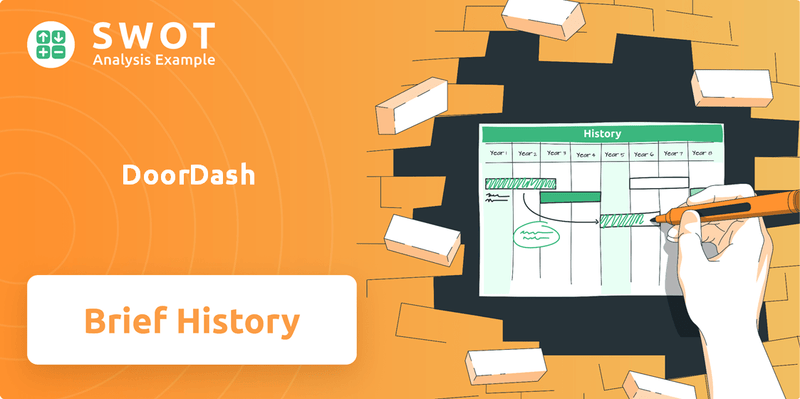
DoorDash's remarkable ascent showcases the power of adapting to consumer needs and leveraging technological advancements. The company's early focus on empowering local businesses through efficient delivery solutions rapidly fueled its expansion. Understanding the brief history of DoorDash is crucial for anyone interested in the evolution of the online food ordering landscape and the impact of delivery app services on the modern economy.
What is the DoorDash Founding Story?
The story of the food delivery giant, DoorDash, began in 2013. It was the brainchild of four Stanford University students: Tony Xu, Stanley Tang, Andy Fang, and Evan Moore. Their initial goal was to solve a real-world problem for local businesses struggling with delivery logistics.
The founders observed a significant gap in the market, particularly for small restaurants. They recognized the need for an efficient delivery solution. This led to the creation of PaloAltoDelivery.com, a prototype that utilized Google Voice and 'Find my Friends' to manage orders and deliveries.
This initial venture was a starting point for what would become DoorDash. The founders' hands-on approach, including personally delivering orders, demonstrated their commitment to solving the problem. This early experience shaped their understanding of the challenges and opportunities in the food delivery sector.
DoorDash was founded in 2013 by Tony Xu, Stanley Tang, Andy Fang, and Evan Moore. They started with a prototype called PaloAltoDelivery.com to address the delivery needs of local businesses.
- The founders acted as the first 'Dashers,' personally delivering orders.
- They secured $120,000 in seed funding from Y Combinator in the summer of 2013.
- DoorDash aimed to be a logistics company, not just a food delivery service.
- The company's mission was to build a local, on-demand delivery network.
The early days of DoorDash were marked by challenges, including securing initial funding. However, in the summer of 2013, they received $120,000 in seed money from Y Combinator. This funding was a critical step in launching DoorDash. The founders focused on creating a user-friendly platform to connect customers with local restaurants. They also built a reliable delivery workforce.
The team envisioned DoorDash as a logistics company, with a mission to 'build the local, on-demand Fedex.' This vision went beyond food delivery. It included empowering small businesses, providing flexible work opportunities, and offering convenience to consumers. This broad approach helped DoorDash quickly grow and expand its services.
DoorDash's success is a testament to its ability to identify market needs and leverage technology. The company's evolution reflects the founders' initial vision of creating an efficient delivery network. To learn more about how DoorDash stacks up against the competition, you might find the Competitors Landscape of DoorDash useful.
DoorDash SWOT Analysis
- Complete SWOT Breakdown
- Fully Customizable
- Editable in Excel & Word
- Professional Formatting
- Investor-Ready Format
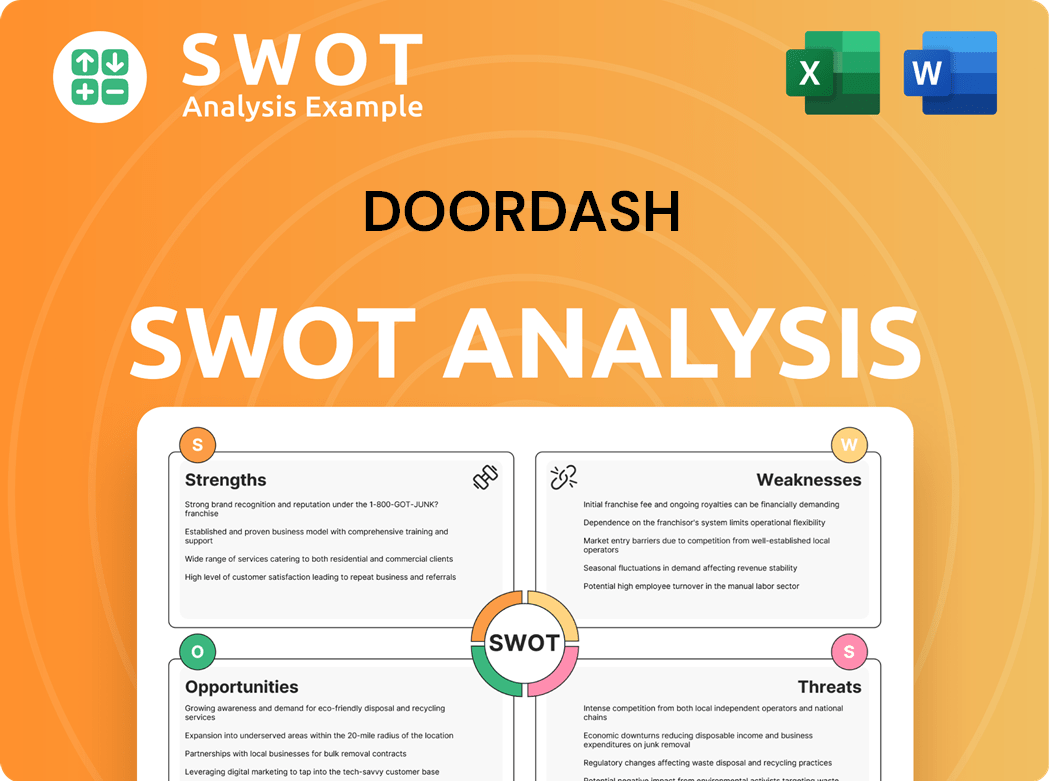
What Drove the Early Growth of DoorDash?
The early phase of the DoorDash company was marked by rapid expansion and strategic investments. After its launch, DoorDash quickly moved beyond its initial base, extending its services to major cities across the United States. This growth was fueled by significant funding rounds and strategic partnerships, which allowed DoorDash to scale its operations and capture a larger market share in the competitive food delivery service industry.
DoorDash secured its initial momentum with seed funding of $120,000 from Y Combinator in 2013. Following this, the delivery app officially launched. By 2014, the company had already begun its expansion, extending its services to major U.S. cities, which laid the groundwork for its future growth.
The expansion of DoorDash was supported by several significant capital raises. In 2014, the company received $2.4 million in Series A funding led by Khosla Ventures. Further investments included $40 million in Series B and $127 million in Series C funding in 2016, which accelerated its market penetration.
DoorDash's growth metrics were robust during this period. Revenue surged by 204% year-over-year to $885 million in 2019, with total orders increasing by 217% year-over-year to 263 million. By March 2019, DoorDash led the U.S. consumer sales for on-demand delivery, capturing 27.6% of the market.
A key strategic shift involved transitioning to a hybrid delivery model, utilizing its own fleet of drivers. DoorDash also diversified its offerings beyond restaurants, expanding into delivering from convenience stores and other categories. For more details on how the company generates revenue, you can read about the Revenue Streams & Business Model of DoorDash.
DoorDash PESTLE Analysis
- Covers All 6 PESTLE Categories
- No Research Needed – Save Hours of Work
- Built by Experts, Trusted by Consultants
- Instant Download, Ready to Use
- 100% Editable, Fully Customizable
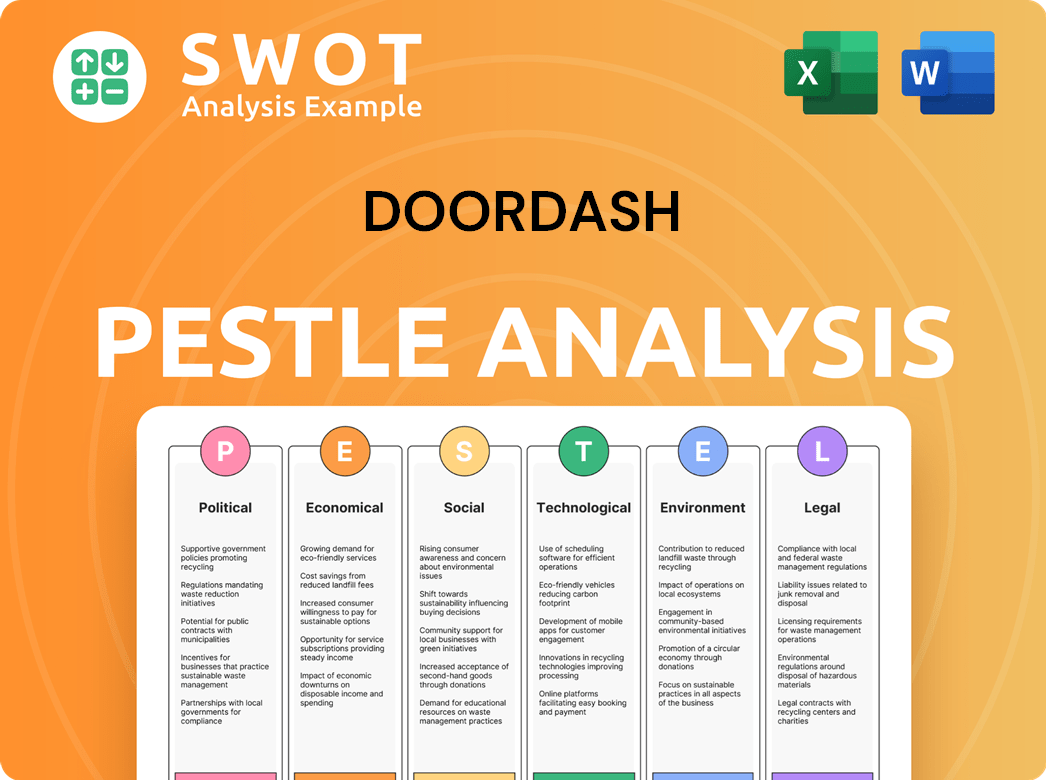
What are the key Milestones in DoorDash history?
The DoorDash company's journey, a significant player in the food delivery service market, has been marked by key milestones, strategic innovations, and persistent challenges, shaping its evolution from a startup to a major industry force. This brief history of DoorDash highlights its key achievements and the obstacles it has overcome.
| Year | Milestone |
|---|---|
| 2013 | DoorDash was founded by Tony Xu, Andy Fang, Stanley Tang, and Evan Moore, starting its operations in Palo Alto, California. |
| 2015 | The company expanded its services, rapidly increasing its presence across the United States. |
| 2018 | DoorDash became the largest food delivery service in the U.S. by market share. |
| 2020 | DoorDash expanded into new verticals beyond restaurants, including grocery and convenience items. |
| 2021 | DoorDash acquired Wolt, expanding its global footprint significantly. |
| 2020 | DoorDash went public with its IPO. |
| 2024 | DoorDash achieved its first full year of positive GAAP net income, with $117 million in profit. |
| 2025 | DoorDash announced the acquisition of SevenRooms, a hospitality technology firm, for $1.2 billion in May. |
| 2025 | DoorDash announced the proposed acquisition of Deliveroo for £2.9 billion ($3.9 billion) in May. |
DoorDash has consistently innovated with its technology. A major innovation is its proprietary logistics platform, which uses machine learning to optimize the experience for merchants, consumers, and delivery drivers. This platform enhances quality and performance, providing personalized content and real-time delivery optimization.
DoorDash uses a proprietary logistics platform that leverages machine learning algorithms.
The company expanded beyond restaurants, adding grocery, convenience, and other categories.
The platform provides real-time optimization of delivery routes and times.
DoorDash offers personalized content to consumers, improving their experience.
The company has made key acquisitions like Wolt and SevenRooms to expand its market presence and service offerings.
Continuous technological advancements have been key to maintaining its market leadership.
Despite its successes, DoorDash faces several challenges. The company has to navigate intense competition in the food delivery service market. Legal battles, such as the lawsuit by Uber alleging anti-competitive practices, also pose ongoing challenges.
DoorDash faces stiff competition from other major players in the delivery app market.
Despite revenue growth, DoorDash has faced challenges in maintaining consistent profitability, although it achieved its first full year of positive GAAP net income in 2024.
DoorDash has encountered legal challenges, including lawsuits regarding labor practices and competition.
The market can be volatile, and economic downturns can impact the food delivery industry.
Maintaining operational efficiency and managing costs are ongoing challenges.
Managing relationships with delivery drivers and addressing labor-related issues are important.
DoorDash Business Model Canvas
- Complete 9-Block Business Model Canvas
- Effortlessly Communicate Your Business Strategy
- Investor-Ready BMC Format
- 100% Editable and Customizable
- Clear and Structured Layout
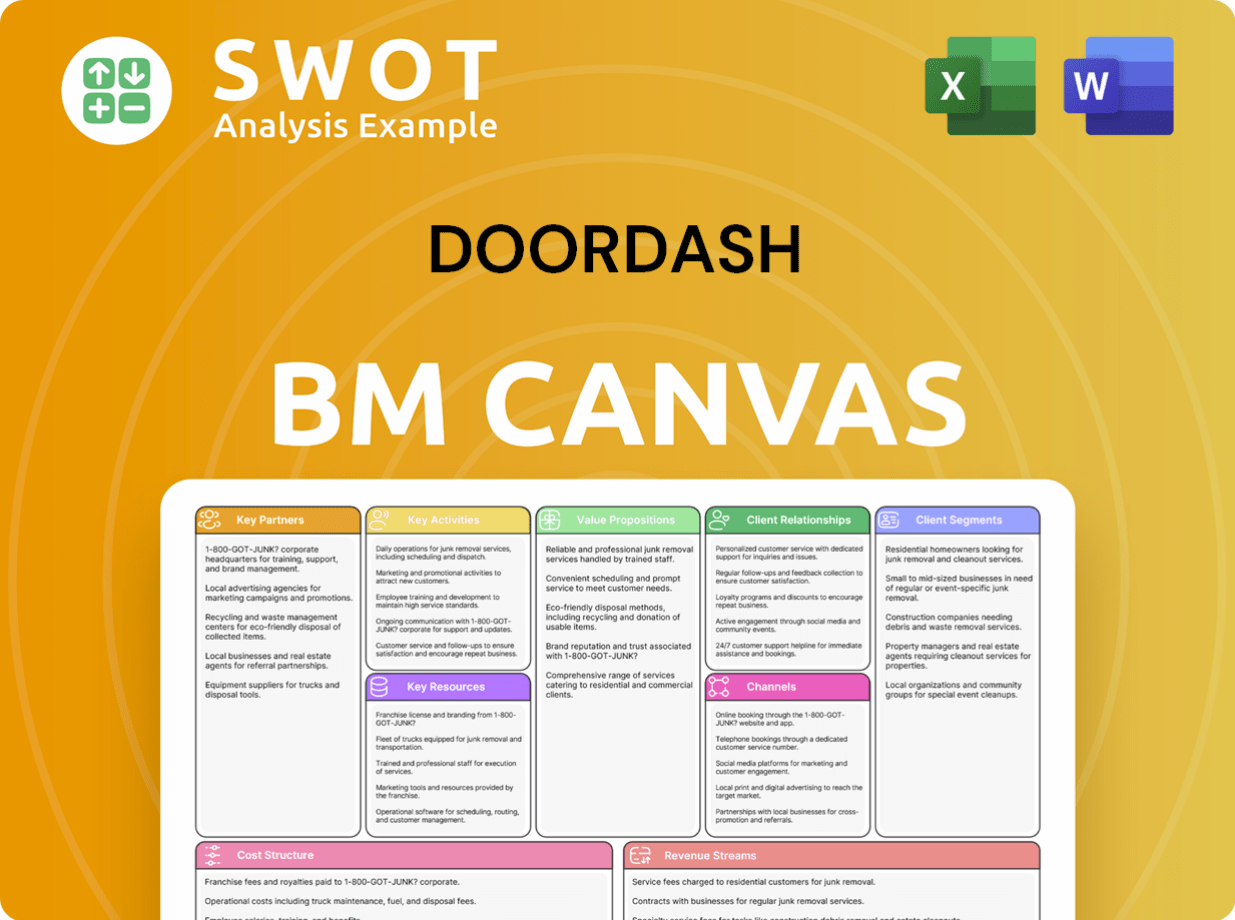
What is the Timeline of Key Events for DoorDash?
The DoorDash history is marked by significant milestones, from its inception to its current position as a leading player in the food delivery service industry. The company's journey has been characterized by strategic expansions, acquisitions, and a commitment to adapting to market demands, with each step contributing to its growth and influence in the online food ordering and delivery app landscape.
| Year | Key Event |
|---|---|
| 2013 | Founded as Palo Alto Delivery by Tony Xu, Stanley Tang, Andy Fang, and Evan Moore in Palo Alto, California, and secured $120,000 in seed funding from Y Combinator, officially becoming DoorDash. |
| 2014 | Expanded services to multiple major U.S. cities and raised $2.4 million in Series A funding. |
| 2015 | Changed its corporate name to DoorDash, Inc. |
| 2016 | Raised $40 million in Series B and $127 million in Series C funding. |
| 2018 | Surpassed Uber Eats to become the second most popular delivery app in the U.S. |
| 2019 | Acquired Caviar for $410 million and raised $400 million in Series G funding. |
| 2020 | Went public on the New York Stock Exchange (NYSE) under the ticker DASH and began expanding into non-restaurant verticals like grocery and convenience. |
| 2021 | Acquired Wolt, a Finnish delivery company, expanding its international reach. |
| 2024 | Generated its first full year of positive GAAP net income of $117 million on revenues of $10.72 billion, a 24.2% increase from 2023, with monthly active users reaching an all-time high of over 42 million by December 2024. |
| 2025 Q1 | Reported revenue of $3.0 billion, an 21% year-over-year increase, with GAAP net income of $193 million, and total orders increased 18% year-over-year to 732 million. |
| 2025 May | Announced the proposed acquisition of Deliveroo for £2.9 billion ($3.9 billion) and the acquisition of SevenRooms for $1.2 billion, aiming to expand globally and enhance merchant services, and partnered with Domino's Pizza for nationwide U.S. launch on the DoorDash Marketplace. |
DoorDash aims to achieve profitability by 2025, focusing on operational efficiency and cost optimization. The company is strategically investing in growth segments such as grocery delivery and international expansion. Analysts project EBITDA margins to expand to approximately 2.8% of Gross Order Value (GOV) in 2025.
For Q2 2025, DoorDash expects GOV to be between $23.3 billion and $23.7 billion. EBITDA guidance is set between $600 million and $650 million. These projections reflect the company's continued expansion and market penetration efforts.
DoorDash anticipates continued growth in its marketplaces and commerce platform. The company plans to invest in business expansion and strategic initiatives. This includes further diversification into new verticals to increase its total addressable market.
Expansion into new verticals is expected to drive future growth. This strategy aims to enhance customer retention and boost order frequency. DoorDash's vision extends beyond food to a broader range of local commerce.
DoorDash Porter's Five Forces Analysis
- Covers All 5 Competitive Forces in Detail
- Structured for Consultants, Students, and Founders
- 100% Editable in Microsoft Word & Excel
- Instant Digital Download – Use Immediately
- Compatible with Mac & PC – Fully Unlocked
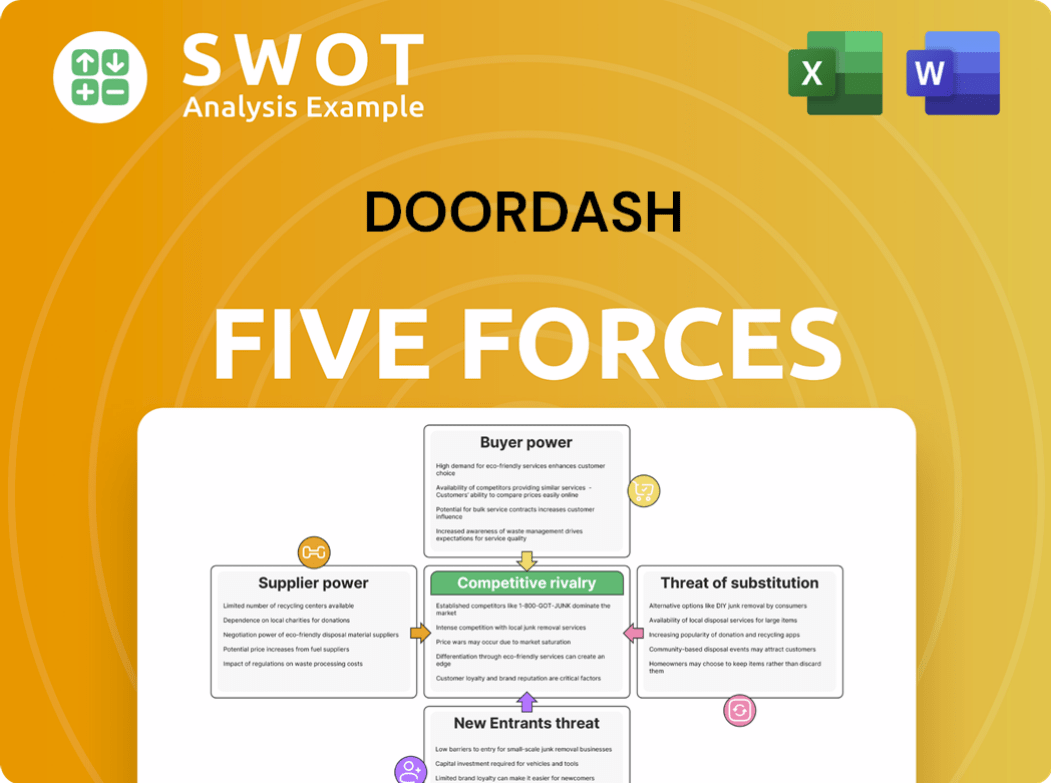
Related Blogs
- What is Competitive Landscape of DoorDash Company?
- What is Growth Strategy and Future Prospects of DoorDash Company?
- How Does DoorDash Company Work?
- What is Sales and Marketing Strategy of DoorDash Company?
- What is Brief History of DoorDash Company?
- Who Owns DoorDash Company?
- What is Customer Demographics and Target Market of DoorDash Company?
Disclaimer
All information, articles, and product details provided on this website are for general informational and educational purposes only. We do not claim any ownership over, nor do we intend to infringe upon, any trademarks, copyrights, logos, brand names, or other intellectual property mentioned or depicted on this site. Such intellectual property remains the property of its respective owners, and any references here are made solely for identification or informational purposes, without implying any affiliation, endorsement, or partnership.
We make no representations or warranties, express or implied, regarding the accuracy, completeness, or suitability of any content or products presented. Nothing on this website should be construed as legal, tax, investment, financial, medical, or other professional advice. In addition, no part of this site—including articles or product references—constitutes a solicitation, recommendation, endorsement, advertisement, or offer to buy or sell any securities, franchises, or other financial instruments, particularly in jurisdictions where such activity would be unlawful.
All content is of a general nature and may not address the specific circumstances of any individual or entity. It is not a substitute for professional advice or services. Any actions you take based on the information provided here are strictly at your own risk. You accept full responsibility for any decisions or outcomes arising from your use of this website and agree to release us from any liability in connection with your use of, or reliance upon, the content or products found herein.